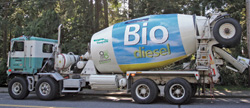
News
Biodiesel strategy could boost canola demand
Canola biodiesel has potential economic benefits for Canadian farmers, but there are many issues and risks to sort out.
November 29, 2007 By Bruce Barker
By the time this magazine hits your mailbox, Canada just might have a national
biofuel strategy that includes biodiesel. Then again, canola growers still might
be on the outside looking in. And worse yet, that large sucking sound you hear
is canola seed siphoning out of Canada and into the US, where large subsidies
and new crushing and biodiesel plants are the norm – taking jobs and value-added
opportunities out of Canada.
 |
| Rempel Bros. Concrete launched a biodiesel pilot in its north Vancouver fleet this spring, with 15 vehicles running B20. Photo Courtesy Of The Canola Council of Canada. |
Already, Canadian canola oil is in high demand in Europe. In 2006, the European
Union (EU) is forecasting the importation of between 100,000 to 120,000 tonnes
of canola oil for use in its biodiesel facilities. In the past several years,
more than Cdn$561 million has been invested in expanding biodiesel production
capacity in Germany alone. From just over two million tonnes of biodiesel in
2002, to approximately six million tonnes in 2006, the EU biodiesel industry
is thriving, with a projection of 14 million tonnes by 2010.
The EU expansion was triggered by the EU Biofuels Directive that set targets
for biofuel share of all transport fuels at two percent by 2005 and 5.75 percent
by 2010. Other policies include fuel tax incentives, carbon-based fuel taxes,
vehicle subsidies, CO2 trading, fuel standards and facilities
incentives.
In the US, John Becherer, chief executive officer with the United Soybean Board
in St. Louis, says that the US biodiesel industry owes a great deal of thanks
to the soybean farmers of America for lobbying, investing and funding research
($35 million) in the US biodiesel movement. Canadian farmers can only dream
of having such a strong influence on Canadian politicians. In the US, various
states have implemented their own biodiesel policies. For example, Minnesota
implemented a B2 (two percent biodiesel) requirement in 2002. Illinois offered
sales tax exemptions and development grants in 2003. Currently, most states
are looking at some sort of mandatory biodiesel content in their diesel fuel.
While the biodiesel industry has developed rather haphazardly with various policies
across different states, it is moving towards harmonization of quality standards,
driven by the demands of diesel fuel consumers.
So where does that leave Canada?
Currently, the federal government has proposed an average of five percent renewable
fuels in 100 percent of the transportation fuels by 2010, with the potential
to increase to 10 percent by 2015. However, there is not a separate requirement
for biodiesel contained in the Renewable Fuels Strategy. As a result, those
targets could be primarily met by ethanol, which is ahead of the game in production
facilities and easier to blend into gasoline. Ethanol also does not have the
same problems with winter flowability.
 |
| Canola oil has potential to reinvent itself as a biofuel. Photo Courtesy Of The Canola Council of Canada. |
One federal initiative that was announced in July 2006 at the Canola Council's
biodiesel conference in Calgary was the Biofuels Opportunities for Producers
Initiative (BOPI), worth $10 million dollars for the current fiscal year. The
initiative is to help agricultural producers develop business plans, as well
as undertake feasibility studies to support the creation and expansion of biofuel
production.
Provincially, biodiesel strategies vary across the country. In Alberta, the
provincial government is playing catch-up and hopes to release a strategy sometime
late in 2006. Saskatchewan recently released a task force recommendation calling
on a federal strategy that includes biodiesel. Manitoba has a biodiesel plan
that includes tax relief on biodiesel blends. Ontario also has tax breaks on
biodiesel blends.
Potential demand will take 45 percent of canola production
There is no doubt that market potential is very high. Mike Bryan, CEO of BBI
International and president of BBI Biofuels Canada, estimates that a five percent
requirement could create a 1.3 billion litre biodiesel market in Canada. But
without a separate requirement for biodiesel, it would have to compete with
ethanol for the five percent market share.
Bryan estimates that building 10 to 12 larger biodiesel plants across the prairies
could produce about 900 million metric litres (MML) of biodiesel – or about
70 percent of the 1.3 billion litre biodiesel market in Canada. This would require
about 45 percent of the average annual production of canola (about eight million
tonnes produced annually) to meet the 900 MML of biodiesel.
In his estimates, Bryan believes that meeting 70 percent of a renewable fuel
strategy with biodiesel would create more than $504 million in new investment;
create 200 direct and 900 indirect jobs; generate $105 million in new revenue
to support industries like electrical and plumbing suppliers; produce $20 million
in new transportation revenue; add $730 million in new agricultural revenue;
and generate $138 million in additional farm income. Those are heady numbers
indeed. If the Renewable Fuels Strategy called for a two percent biodiesel component,
then Canada would require about 0.5 billion litres of biodiesel – cutting
Bryan's estimates down by half.
So, will canola farmers become the oil Sheiks of the future? Not likely, says
Brian Chorney, a farmer from East Selkirk, Manitoba and Canola Council Growers
Association Biodiesel Committee chair. Canola has to compete with other feedstocks,
such as soybean oil and palm oil. With a least-cost feedstock approach, the
benefits to canola growers would be minimal, especially if large imports of
palm oil are allowed into Canada as a feedstock.
Chorney says the first step in developing a strategy is to have a federal standard
in place that would call for a two percent biodiesel content in the renewable
fuel standards. That in itself would start to develop a market for canola biodiesel,
especially for low grades of canola.
 |
| Municipalities have led the way in biodiesel adoptions in Canada. Photo Courtesy Of Saskatoon Transit. |
As far as incentives for Canadian production, Chorney calls for parity with
the US, which includes a $1 per gallon blender's credit (roughly $0.29 per litre)
and faster capital depreciation for plants. He also suggests that growers need
to participate in the biodiesel industry and that a Grower Equity Assistance
Program with matched funding from the federal government would provide a boost.
Hurdles to overcome
While incentive parity with other countries is a high priority, as
is establishing a biodiesel component in the Renewable Fuel Strategy, winning
over consumers will take effort. Rick Moskowitz with the American Trucking Association
says that while his organization supports a biodiesel initiative in the US,
there are issues that need sorting out.
One key issue is that quality and policy must be uniform. Long distance truckers
who might have a B20 blend in Florida will run into cold flow problems when
they hit a Minnesota winter storm. Moskowitz also says that quality has been
an issue in the US and that national standards are crucial.
Another issue is cost. Diesel fuel is a trucker's second biggest cost behind
labour and, according to Moskowitz, the trucking industry cannot afford to pay
more for biodiesel. As a result, he says government will have to step up and
pay the difference. Moskowitz says that the trucking industry needs to be at
the discussion table when developing policy since it consumes 65 percent of
the diesel fuel sold in the US. He also does not see the need for blends greater
than B5.
Gerry Ertel, manager of Regulatory Affairs with Shell Canada in Calgary, says
that the distribution of biodiesel can be problematic. The company does not
want to see biodiesel blended at the pump. Rather, he says it must be quality
controlled at the refinery so that the company can stand behind the quality
standards.
While Ertel says that first generation biodiesel from plant oils will lead
the way in early development, Shell and other companies are working on second
generation processes that will produce biofuels from plant residue like straw.
He also says that companies are experimenting with plant oils as a feedstock
for refineries, running the oil through as part of crude, rather than blending
diesel and biodiesel together downstream of the refinery. By running it through
the refinery, Ertel says the 'biodiesel' is a better product that is more easily
handled.
 |
| Saskatoon Transit ran a pilot project on biodiesel. Photo Courtesy Of Saskatoon Transit. |
Already, Brazil's national oil company is running raw vegetable oil through
refineries at a rate of two percent by volume, with plans to move towards 10
percent. This is of obvious concern to biodiesel production facilities. Rather
than requiring a biodiesel facility, the only processing facilities required
would be canola crushing facilities to supply refineries with raw canola oil.
What needs to be done in the short-term?
There are a lot of challenges and unanswered questions. Barb Isman, president
of the Canola Council of Canada, says that there is a short time frame to create
favourable conditions for the construction of biodiesel plants in Canada. She
says that currently, there are large companies who are, or want to be, players
in the biodiesel industry in Canada and they are actively planning to spend
hundreds of millions of dollars on new biodiesel plants.
Isman explains that conditions are right for such investment in the US, but
they are not in Canada. If that does not change soon, those new plants will
be built south of the border. She summarizes that Canada must come up with a
biodiesel strategy that includes the establishment of a market for biodiesel
by requiring a minimum two percent biodiesel blend by 2010; that quality standards
must be established to ensure a consistent, quality product across the country;
that a Canadian strategy must match US incentives for biodiesel; and finally,
that the strategy makes it possible for growers to have an ownership stake in
these plants so that rural communities can benefit from this investment.
As Chorney says, a rising tide will float all boats. How much the tide rises
for Canadian farmers, though, hinges on a strategy that keeps biodiesel processing
in Canada.